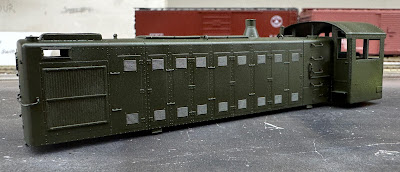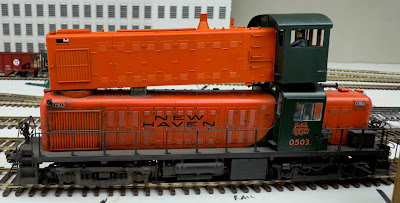Marc at work had a small stack of a little over 100 Home Route cards that came out of Springfield. The cards are all dated from February and March 1946, although not all originally routed through Springfield.
Springfield
For Springfield there are 29 roads represented (71 cars, one of which I can't identify the road). They are not necessarily roads I expected.
- PRR - 10 - 14%
- B&O - 8 - 11%
- BM - 7 - 10%
- CP - 7 - 10%
- ATSF - 4 - 6%
- CNJ - 3 - 4%
- FGEX - 3 - 4%
- CG - 2 - 3%
- D&H - 2 - 3%
- GARX - 2 - 3%
- MDT - 2 - 3%
- MEC - 2 - 3%
- RDG - 2 - 3%
- SRLX - 2 - 3%
- ARLX - 1
- ART - 1
- BLE - 1
- ERIE - 1
- IC - 1
- L&N - 1
- MILW - 1
- NADX - 1
- NH - 1
- NP - 1
- PFE - 1
- SOO - 1
- SOU - 1
- VGN - 1
The mix of cars is also interesting:
- Box Cars - 25 - 35%
- Reefers - 14 - 20%
- Hoppers - 21- 30%
- Gondolas - 7 - 10%
I was surprised to see two Canadian Pacific stock cars and a ventilated box car (Central of Georgia).
Ventilated box car CG 55991 arrived via Springfield on February 18, 1946. It went to Bridgeport on February 20. It appears to have been released on February 28, and was then routed via Cedar Hill on March 1 on its way back to Springfield, also on March 1. It's interesting that it came into the NH via Springfield, but assuming it was empty on the way out, the car routing rules indicate it should be sent out via the same route it arrived.
The selection of cars routing via other points is too small for any meaningful analysis, but still interesting. There was one Southern box car via Harlem River and one CN box car via New London. Via Worcester there was an MEC and Wabash box car.
Bay Ridge (15 cars)
CP, PFE and SOO with 2 cars each, plus one each of ART, BM, GARX, NP, OWR&N, SAL, SFRD, and Southern.
Seven each of box cars and reefers, and one hopper (Boston & Maine).
Oak Point (10 cars)
Half were CP, 3 box cars, a reefer and a stock car. Two Southern box cars, and an ART and MDT reefer.
Maybrook
Thirteen cards were for cars routed via Maybrook. Eight of those were reefers: 1 ART, 1 LRX, 1 MDT, three PFE and an SFRD. I'm not sure on the last one. Two CP box cars, and one each of B&O, BAR, and IHB.
--
Although the number of cards is too small to derive any real info regarding routing, I think there are still some interesting things to note.
I was surprised as the number of Pennsy and B&O cars coming via Springfield, but I have a probably explanation. I think many of these specific cars were on their return leg. That is, a B&O or PRR box car that originally carried a load to, say, Maine was unloaded when it arrived at its destination. Car routing rules specify a car that is not reloaded be routed back the same way it arrived. If the car was originally routed to the B&M via the New Haven, it would have likely gone through Springfield. So it would come back via Springfield too. They could also be loaded and routed via the NH.
What does that mean for my modeling purposes? That cars I might not have considered routing via Springfield could be part of the consist of a Hartford to Maybrook freight.
This is the first documentation in my era of a ventilated box car on New Haven rails. I was also surprised the two stock cars were CP, one at Springfield and one at Oak Point.
The mix of hoppers is always something I'm interested in learning more. In this case it was B&O (4), BLE (1), B&M (2), CG (1), CNJ (2), D&H (2), Erie (1), NH (1), PRR (6), RDG (1), and VGN (1). The anthracite roads all make sense, although all of them were via Springfield. The D&H cars were probably loaded, but I suspect the others were all empties on their way home.
The B&M ones (one at Springfield and one at Bay Ridge) are more interesting. Without knowing the commodity, I'm guessing these cars may have been related moves since they had so few hoppers.
The CG and VGN were also unusual. If they were bituminous coal, they were a long way from home, especially when the bulk of coal from their region would have come by water via Baltimore. Again, these went via Springfield, so it's likely that the NH was simply part of the routing.
I also didn't expect reefers to be the second most common cars. The mix was not quite what I expected (although being February would have an impact on what commodities were shipping and from where). PFE was the most numerous at six, but ART and MDT were second with four each. CP, FGEX, and GARX all had three, and SFRD and SRLX had two each. The LRX car is an interesting one too, not many of those.
There are no tank cars at all, but this is expected because they always ran on a waybill. They would not use Home Route Cards.




















.jpeg)
.jpeg)


%200500%20Builder's%20Photo.jpg)
